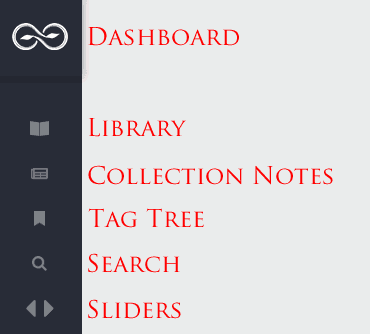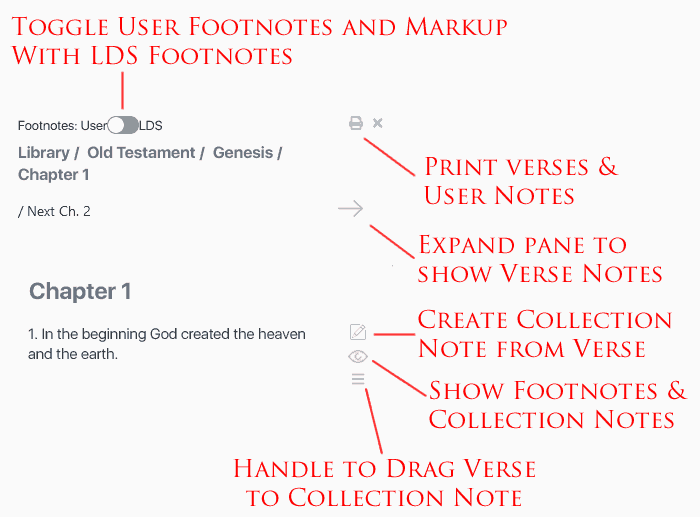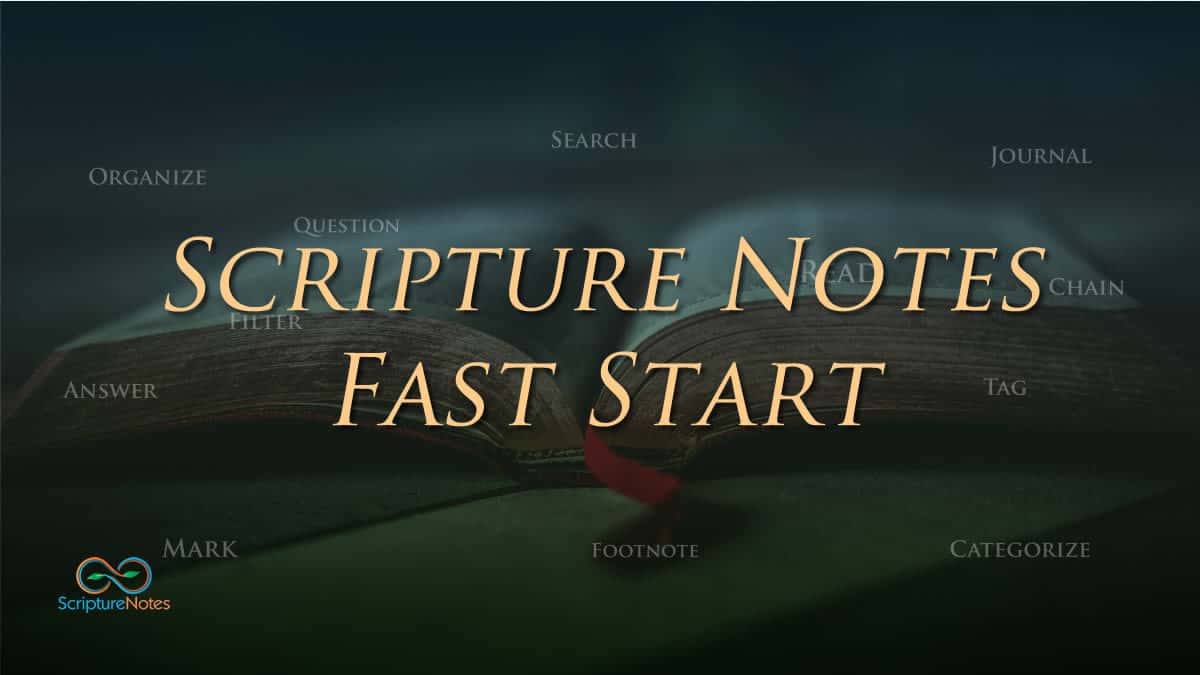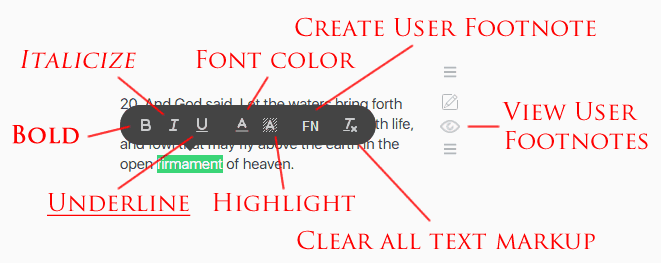Quick Reference Screenshots
Master Navigation

Library
In the library and reading panes, you can now Ctrl/Cmd-click a link and open it in a new browser tab. You can Alt-click a link and open it in a new pane. For example, if you were reading Genesis 1 and Alt-clicked the next chapter, Genesis 2 would open in a pane to the right. If you Ctrl/Cmd-click “Old Testament” at the top of the pane, you would open a new browser tab displaying the books of the Old Testament to click into.

Reading

User Markup Tool
LDS Footnotes
Search

Search Results
Collection Notes

Collection Note Pane
Tags
Drag & Drop Panes to Rearrange
Scripture Notes Fast Start Transcript
Welcome to the Scripture Notes fast start training. If you haven’t signed up for a free account, please do so and over the course of a couple weeks, I’ll send you tutorials that will make you a scripture studying genius.
Lets get started. When a user first logs into the application, you’ll see your menu bar on the left. Each icon opens a window pane to the right.
The top icon opens your dashboard. Here you’ll see a quick history of the things you’ve studied and searched for so you can quickly click and open them back up. You can also change your password, subscribe, and log out from this screen.
The next icon down opens up the reading pane. Here you’ll see your library and can navigate to a book and chapter. When the chapter opens, you’ll see an arrow to click to expand or contract the pane to see basic chapter and verse notes. This is a single memo field that will hold everything you want to store about that one chapter heading or verse. It will save your field of information as soon as you exit it, so to save what you’re working on in verse notes, just click anywhere outside the box.
There are a few icons to the side of verses. Clicking the top one will open up a collection note for that verse. I’ll demonstrate more about collection notes in a minute, but in short, this lets you create a note that is offset in a special way. You might paste in a lengthy quote and want to tag it and associate it with a verse, but not put it in the basic verse note. The tutorial series will demonstrate this in different ways. You can also drag additional verses into a collection note if you want to associate the note with other verses.
The next icon will show you the collection notes associated with this verse, as well as any footnotes in this verse.
The last icon is a drag reference so you can click here and drag a verse into a collection note.
By highlighting text in the verse, you can bold, italicize, underline, change the font color, highlight the text, create a footnote, or clear your markings easily.
The breadcrumb trail at the top of the reading pane will let you navigate to a new chapter in that pane, whereas clicking a book and chapter in the library pane will open a new reading pane.
Now let me jump to the search icon because this is going to drive what happens on the other panes.
The magnifying glass icon opens the search feature. This is where things get really exciting. Lets say I want to do a search for all instances of the word “cross”. I get my results in a new pane to the right of the search pane. If I do another search from the search pane, such as “resurrection,” it will open up another search results window without affecting the search results I currently have open. If I want to modify my search results in the search results window such as removing all verses that contain variations of the word water, I add “-water*” and the results in that pane drop from 55 to 48.
If I click the arrow at the top I can now go down these search results and edit the verse notes for the results. This is incredibly effective to quickly search and post revelatory thoughts about a set of verses.
There’s also a new set of buttons here to the right of the verse notes. The icons on the right you’re already familiar with from the reading pane, but now, there’s an up and down plus button, and a minus button in the middle.
The plus buttons let you add the previous or next verse so you can see the verse in context. Clicking the minus button will let you remove a verse from the search results if it’s irrelevant.
Now we get to my favorite feature. Why do a search unless there is a way to save that search and summarize your thoughts on the topic?
Look at the “Create CN” button at the top of the search pane. Clicking it creates a collection note with all the verses added to it that were in your search pane. Click the arrow to expand the window and you’ll see the basic verse notes and the entire interface.
In the collection note screen, at the top you’ll see you can add a title for the note, topic tags, and categories. The title is how this note will appear next to all the verses in the collection.
The tag box is for all the topics this note should be associated with in your tag tree. Enter a word and hit enter to lock in that topic. You can also create sub-tags for 2nd level tagging by using a colon in-between the first and second level like “Faith:Action”.
The categories dropdown lets you select what type of note this is. This is optional. You can select none, or all of these categories. The purpose is, later on, you might remember recording a personal story in a collection note on a topic of faith. You’ll be able to do an advanced search and look for personal experiences that have a tag or text of faith in them. This will provide extra power in locating resources as your personal library builds.
The master note window at the top has all the major markup tools. This is for creating a summary of the verses below, as well as bringing in any outside resources you want to. It’s a powerful way to summarize a topic.
When you want more space to type, or more space to study the scriptures, click and drag the horizontal bar between sections, up and down so you can adjust your workspace.
As previously noted, the verse notes save when you click outside their box. However, collection notes require you to click the save or update button in order to make your collection note a permanent part of your database. Click save as soon as you get your title and tags entered, and then update the note periodically, and for sure when you’re scrolling around. Don’t lose your special notes!
Suppose you realize while working on a collection note that there is another verse you need to add. Open up a reading or search pane with that verse, and simply drag it over to the collection note. Click save and it’s part of that collection. Awesome power at your fingertips!
Back to the search pane. Click on Advanced search. In this pane, you can do advanced filtering on search terms. You can search for words just in a particular book, a particular note type, or tag topic. You can also search for a collection note by category. This provides an extreme level of search power for finding things in your Scripture Notes database.
Now lets return to the menu items on the left.
Click the collection note icon. Opening it up will show you the last several notes you’ve been in, in case you want to return to one and continue your work. The display shows the title and first sentence of the master note so you can see how the note starts. Clicking “Create CN” at the top of the pane will let you create a blank collection note. Something cool you can do is create a collection note of quotes on a topic. You could create a topic for humility and title it “Humility quotes” and not associate it with any verses. Then open it up any time to modify or review the quotes.
The next icon is the tag tree. As you tag your collection notes with certain topic names, they will appear here under the words you’ve used in creating the tags.
If panes ever go off your screen to the right (and they frequently will), you can use the double triangle icons on the left to scroll your screen, or use a trackpad. If you don’t have a trackpad, I recommend adding one to your computer as an external mouse. You can have both a mouse and trackpad installed simultaneously.
There are many more powerful features coming to Scripture Notes. If you haven’t signed up for a free account yet, please do so now. If you have, you’ll start getting the tutorial emails tomorrow. In them, I’ll teach with specific examples how to get the most out of using this application.
Now log in, open up your favorite chapter of scripture and in the basic verse notes, start journaling all the thoughts that come to you about the verses. Write down your questions and answers. Highlight and underline the verses. Get familiar with the system because the next email you get will begin your scripture Jedi training.
Thanks for watching. See you tomorrow.










On a Mac I believe Ctrl/Command is actually “Shift”/command. It didn’t seem to work for me the other way. Just FYI
Can you give me an example Erika? I just tested on my Mac and shift doesn’t do anything special. Command-click opens things in a new tab, and alt-clicks open items in a new pane.
Where did the Footnote (FN) feature go? I can’t find it. I’m specifically using app.scripturesnotes.com on Chrome.
Hi Matt, we turned it off due to some issues with things. Eventually it will come back.